We live in a post-billiards age. There was an age of billiards, and it has been over for so long, most of us have no idea how huge billiards once was. For many decades, starting in the mid-19th Century, billiards was one of the most popular amusements.
A hundred years ago, there were 830 pool halls in the city of Chicago. Today, there are ten.
Billiards is not what it used to be—but we continue to live in a world affected by its former prominence. The growth of billiards led to the development of a material that would come to define the modern world. Without billiards, we might never have discovered plastic.
The story starts with a man named Michael Phelan, the father of American billiards.
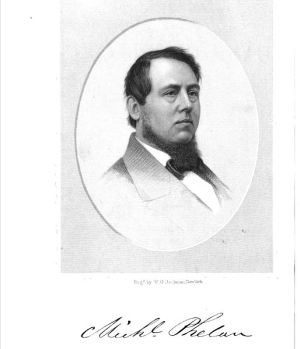
Phelan was a brilliant player, and he also promoted the sport, arranging the biggest big-money matches.
He opened huge billiards halls in San Francisco and New York.
And Phelan believed that to further popularize the game of billiards, he would need to standardize the gear. If tables and balls weren’t the same from one location to another— well, you were basically playing a different game every time you went somewhere new.
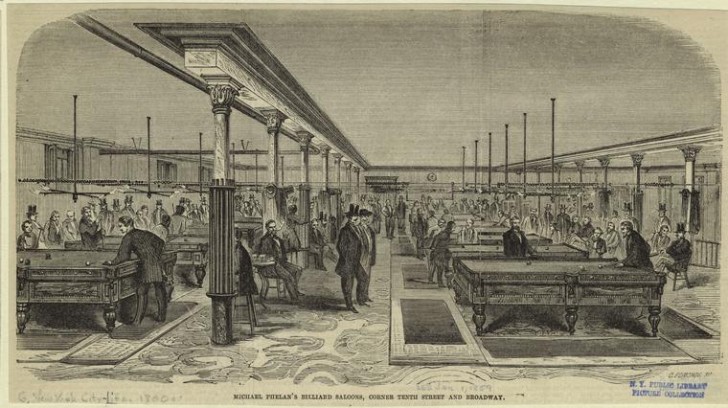
So he patented a new kind of billiard cushion. And then, he took the money from that, as well as what he had won playing billiards and writing books on billiards, and used it to become the first big manufacturer of billiards tables and equipment.
But standardizing the billiard ball was no easy task. The ball has to have certain physical properties—it has to rebound properly, and be of uniform density.
And, at the time, there was really only one material that would do: ivory.
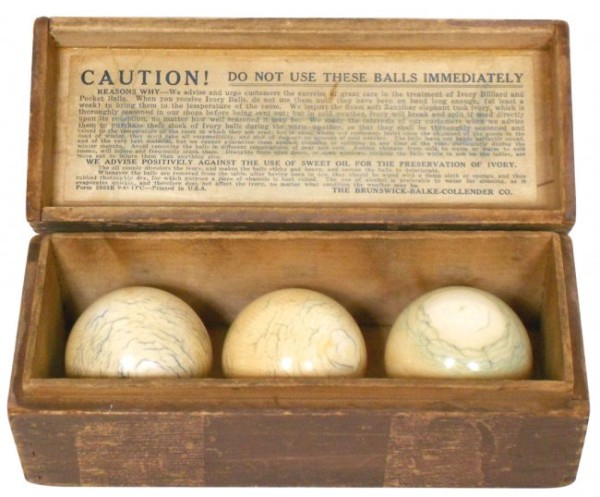
Ivory was not cheap. Going to Africa, shooting elephants, processing their tusks and shipping them across an ocean was dangerous and expensive. Not to mention horrible.
People in the billiards industry started looking for substitutes for ivory. They tried a variety of materials, like wood and iron, but they didn’t perform nearly as well. Ivory balls had just the right weight, the most even roll, the best rebound. Nothing was as good. And not only that, but only the best grade ivory would do. In fact, records from the ivory trade sometimes refer to the top grade as “billiard ball ivory.”
Billiard balls required a lot of billiard-ball grade ivory. Unlike the ivory on piano keys, which were just a veneer of over wood, billiard balls had to be made of 100% solid ivory.
The average number of billiard balls that could be obtained from a single tusk was three.
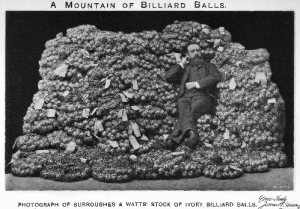
The cost of ivory billiard balls was a problem for Phelan, who was trying to grow his company. He and his colleagues were acutely aware that they needed another material to work with.
Phelan took out an ad in the paper, offering $10,000 to anyone who could come up with a suitable replacement for ivory. In terms of wages people earned at the time, that was like three million dollars.
A tinkerer named John Wesley Hyatt found the ad. Hyatt was a printer, not a scientist. But in his work, he used a number of different chemicals, including nitrated cellulose. Nitrated cellulose was used by printers to protect their hands and is still sold today as liquid bandages.
Hyatt found that the material turned out to have very interesting properties. In particular, when dissolved, it created a kind of syrupy liquid. He tried making a film out of it, and then putting it through a press. In doing this, he created the first plastic. He called it “celluloid.”
But Hyatt did not win Phelan’s prize. Celluloid turned out to be useful for a number of things, but it was not right for billiard balls. The balls just didn’t bounce right.
Hyatt tried to make a go of it anyway, setting up his own billiard ball company, making balls with a thin veneer of celluloid over a layer of plaster on the inside. But they were considered very inferior billiard balls.
Still, Hyatt didn’t give up on celluloid. He went into business with his brother Isaiah, setting up companies to try to find new uses for the material.
Eventually, they find that the best use for celluloid is imitation ivory. Albeit, not for billiard balls, but for versions of popular ivory luxury goods, such as knife handles, combs, and hand mirrors. And of course, celluloid would eventually be used to make film for movies.
Though celluloid had one fatal flaw: it burned easily. Celluloid film caused several disastrous and fatal fires in movie theaters.
Celluloid hadn’t worked for billiard balls, but it did inspire others to make other types of plastics. One of them was Leo Baekeland, who, in 1907, came up with a new kind of petroleum-based plastic. He named it Bakelite, after himself. And Bakelite plastic was perfect for billiard balls.
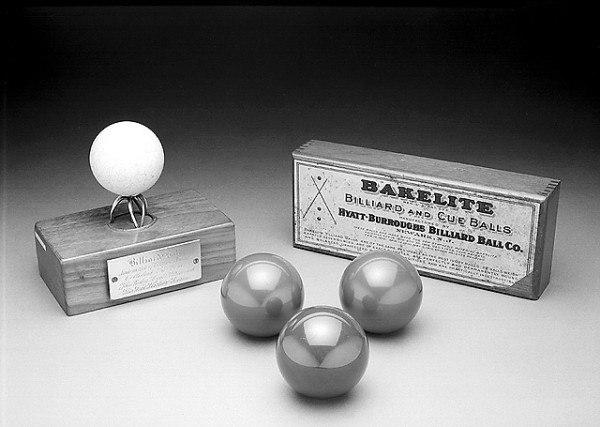
By the 1940s, even top pool tournaments were being played with plastic balls. But by then, pool had passed its peak. It crashed as the Depression began, and never regained its former prominence. The age of billiards was over.
We have been in the post-billiards age—the age of plastics—ever since. Michael Phelan would be very sad about the state of billiard nows. He loved the game so much that he concluded his magnum opus on billiards with five pages of rhyming couplets




Comments (11)
Share
loved the episode as always. one minor correction however; Bakelite is a thermosetting plastic and cannot be melted.
Too bad about the political crack at the end. Your show, your rules, of course.
An exhibit at the National Gallery of Canada last year included architectural drawings for new homes for the well-to-do from the late 19th-early 20th century: Every house had a Billiards Room on the ground floor.
Drat, I really thought this would go into the billiards culture of America, especially pre-1900s. Know where I can get a fix for that?
Another really great episode (although, most of ’em are…) I look back with nostalgia upon an age when you could make billiard balls out of guncotton, and nobody ever uttered the words, “risk assessment”.
Celluloid has found a home in guitar manufacture. Fancy electric guitars have various bits bound in ivoroid (ivory colored celluloid) and guitars not fancy enough to have real pearl have pearloid (pearl colored celluloid) fingerboard inlays.
What happened to all those (100s of 1,000s?) ivory pool balls? Did they disappear with the enthusiasm for billiards? They must be worth even more now – is there any use for old, round, ivory?
It’s interesting to learn about the history! Thanks for sharing this useful information.
WELL, YA GOT TROUBLE MY FRIEND
Came here from the EngineerGuy youtube channel. Great episode.
And now, over a century later, we’re building passenger vehicles out of plastics—albeit of the carbon-reinforced variety. Look up the manufacturing process of the BMW i3 and i8 of you get a chance. They’re the first mass-produced CFRP passenger vehicles, iirc!
Great episode! Good to hear some Antipop Consortium, too.